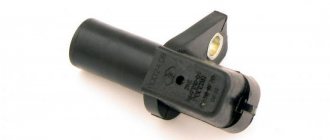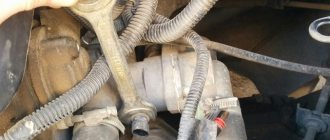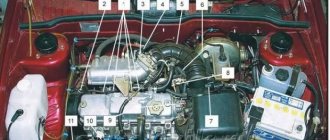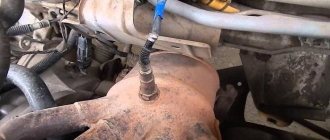This article describes all injector sensors on VAZ family cars. The article is generalized, since all sensors installed on cars of the Volzhsky Automobile Plant are identical to each other and even interchangeable.
After studying the article, you can easily determine the location of the sensor, understand its symptoms of malfunction, and also learn about its purpose. This material only talks about sensors on fuel-injected cars, since there are negligible numbers of engine control sensors in carburetor versions, and besides, there are fewer and fewer carburetor cars.
The engine control unit
All injection Ladas have a special unit that reads and processes readings from all sensors in the car system. This block is a small part made of plastic and metal, inside of which there is a microcircuit with many radio components. It is this block that sends signals to the fuel pump, injectors and ignition module, and also forms the ignition timing, controls the operation of fans, etc. This is a kind of car head unit.
Location
In all Lada models it is located in the cabin, in classic Lada models it is located under the glove box, in front-wheel drive Ladas the ECU is located under the center console. The location of the ECU can be called a problematic place in Lada Granta and Kalina cars, since the ECU is located under the heater radiator, which quite often exposes it to getting wet with antifreeze and disabling it. Many owners of these cars move the ECU under the glove box.
Symptoms of a problem
The unit does not have a malfunction as such; its failure may be associated with the failure of any of the sensors. For example, if one of the cylinders fails, the problem may lie not in the ignition module or coil, but in the key located in the ECU. Often a radio component that burns out inside the unit can affect the operation of any of the sensors.
Where is the mass of the VAZ 2114 ECU located?
The first ground pin from the ECU on cars with a 1.5 engine is located under the instruments on the power steering shaft mount. The second terminal is located under the instrument panel, next to the heater motor, on the left side of the heater housing.
Location of the mass of the VAZ 2114 ECU
On cars with a 1.6 engine, the first terminal (mass of the VAZ 2114 ECU) is located inside the dashboard, on the left, above the relay/fuse block, under the sound insulation. The second terminal is located above the left screen of the center console of the instrument panel on a welded stud (fastened with an M6 nut).
Crankshaft position sensor
Installed on all Lada cars with an injection engine, it serves to determine the top dead center of the piston. Based on its readings, the engine control unit reads readings about the position of the pistons in the engine. After receiving the data, the ECU sends signals to the ignition module and injectors to supply a spark and fuel at the right time and into the right combustion chamber of a certain cylinder.
The sensor operates on the principle of electromagnetic induction. It itself is made of plastic, inside of which there is a magnet with a winding. A drive disk (crankshaft pulley) rotates next to the sensor, from which the sensor reads readings. There is a special slot on the pulley, the so-called “caries”, this slot makes it clear to the sensor what position the pistons and crankshaft are currently in.
Location
The sensor is located on all Frets in one place, near the generator drive pulley, this part is attached via a bolt. On the oil pump body there is a special cast bracket in the form of an ear; the sensor is inserted into it and secured with an M6 bolt.
Symptoms of a problem
If the crankshaft sensor fails, the car will not start due to a missing spark and injectors not working. Loss of communication with the sensor blocks the operation of the ignition module and injectors, causing fuel to enter the oil, etc. Also, if the sensor breaks down, the engine may start to stall, but this only happens when the sensor has not yet completely failed.
Changes in hardware implementation
In 2010, new versions of the hardware implementation of the M73 ECU appeared. In order to reduce the cost, the TDA3664 chip was removed from the circuit, which provided power to the processor (and, accordingly, RAM) when the ignition was turned off. Of course, in this case, the data of all adaptations would be lost, but in the new firmware I(A)303CF06 and I(A)327RD08, before turning off the processor power, the adaptation data is written to EEPROM. When the ignition is turned on, the contents from the EEPROM are written to RAM, so the ECU behaves exactly the same as if the power had not been turned off. In order to implement this algorithm, the EEPROM 95160 (or Atmel 25160) chip must be installed in the unit, instead of the previously installed 95080. Thus, it turns out that for older firmware versions to work, the ECU must have TDA3664 and EEPROM of any size installed, and for new firmware - TDA3664 is not needed (but if installed, it will not interfere with work), and the EEPROM must be of double capacity (95160 or 25160). Take these features into account when chip tuning these ECUs, otherwise the system will not be able to work normally. It should be noted that the latest M73 blocks of the old hardware implementation already had EEPROM of double capacity, therefore, they are the most universal, you can “pour” any firmware into them.
At the beginning of 2010, varieties of ECUs appeared with a factory sticker-sticker “DPKV”, which is located to the right of the main sticker. However, the firmware identifier (and the firmware itself) remained the same. In such ECUs, the polarity of the crankshaft position sensor connection is reversed (this is due to changes in the vehicle wiring).
At the end of 2016, new hardware versions of the ECU appeared (we came across an ECU T21126-1411020-32 with firmware I373DB03). The main differences: the DPKV channel is not made on a specialized TA8025L chip, but on a dual general-purpose comparator LM2903. A little later we will test the operation of such a channel on “evil” naturally aspirated engines at speeds above 10,000 rpm. It can be assumed that the simplified circuit design will not be so good. The second difference, which can only be noticed by bootloader developers and those who directly write software for firmware: in the old hardware versions of the ECU that are familiar to us, the ST10F273-CEG processor was used, which in fact was an ST10F276 processor. That is, it had 832 kB Flash and 68 kB RAM “on board”. The new versions use the ST10F273M-ABG3 processor. This processor is already a “true 273rd”, it has 512 kB Flash and 36 kB RAM. No other hardware differences have been identified yet.
Please note that this website is for informational purposes only and under no circumstances constitutes a public offer defined by the provisions described in Part 2 on page 437 of the Civil Code of the Russian Federation.
Source
Knock sensor
With the advent of injection engines in Lada, regulation of the ignition timing angle (IAP) went into oblivion. This task began to be performed automatically, but as is known, the quality of the fuel also affects ignition, therefore, in order to avoid large detonations in the engine when using low-quality fuel, a knock sensor was used, which detects the slightest detonations in the engine and transmits the readings to the ECU, which in turn, changes the OZ to ensure normal engine operation.
The DD is a round part with a hole inside for attaching it to the engine body. It works similar to a piezoelectric element, that is, when struck, it produces a small electrical voltage. When detonations occur in the engine, the sensor detects them and transmits voltage pulses to the engine control unit to adjust the SOP.
Location
On all Lada models, regardless of the drive type, this part is located on the engine block and secured with a bolt. There are also sensors that themselves have a thread and are screwed into the body of the cylinder block. More precise location of the sensor in the center between cylinders 2 and 3.
Symptoms of a problem
If the sensor breaks down, the engine begins to operate in emergency mode, that is, the ECU can no longer adjust the OZ, and if you refuel with low-quality fuel, then an unpleasant knocking sound appears on the car, and its operation becomes uneven and rough, vibrations appear at idle and consumption increases fuel.
Coolant temperature sensor
In carburetor Lada models, the coolant temperature sensor was used to turn on the cooling fan, but in the injection version of cars, this DTOZ began to perform several functions. For example, the sensor in modern modes is involved in adjusting the fuel mixture, turning on the fan, and also displays information about the coolant temperature on the dashboard. The fuel mixture is adjusted based on temperature, that is, when the engine is cold, it needs a rich mixture, but when the engine is hot, the mixture needs to be leaner.
Location
The sensor can be found under the car air filter housing; it is located in the thermostat housing and is connected to a connector with two wires. The sensor is screwed in through a threaded connection, and a special O-ring is located between the DTOZH and the thermostat body.
Symptoms of a problem
When the sensor fails, the car experiences increased fuel consumption, as well as a lack of warm-up speed, the engine may begin to have trouble starting. All of these problems indicate a problem with the temperature sensor.
Parameters of sensors of VAZ injection engines: table, check and replacement according to the diagram and
Optimal operation of a car engine depends on the parameters of many devices. To ensure normal operation of VAZ engines, they are equipped with various sensors designed to perform different functions. What you need to know about diagnosing and replacing controllers and what are the sensor parameters of VAZ injection engines, this table is presented in the article.
Typical operating parameters of VAZ injection engines
Checking VAZ sensors is usually carried out when certain problems are detected in the operation of the controllers. For diagnostics, it is advisable to know what malfunctions of VAZ sensors can occur, this will allow you to correctly and quickly check the device and promptly replace it. So. it, how to check the main sensors like VAZ and then replace them - read Basic.
Below are the parameters of controllers on injection engines. Features
VAZ, diagnostics and replacement of elements of VAZ systems for car injection
Below we will look at the main Halls!
controllers
There are several options for how to check the Hall sensor of a VAZ:
- Use a known working device for diagnostics and install it instead of the standard one. If after replacement the engine problems stop, this indicates a malfunction of the regulator.
- Using a tester, diagnose the voltage controller at its terminals. During normal operation of the device, the voltage should be from 0.4 to 11 volts.
replacement The procedure is performed as follows (the example process is described in the model 2107):
- First, the distribution device is dismantled and its cover is unscrewed.
- Then the slider is dismantled; to do this, you need to pull it up a little.
- Remove the cover screw that secures the plug and unscrew it.
- You will also need to unscrew the bolts that secure the plate to the controller. After this, the screws that secure the vacuum corrector are unscrewed.
- Next, the retaining ring is dismantled and the rod itself is removed along with the corrector.
- To disconnect the wires, you will need to move the clamps apart.
- The support plate is pulled out, after which several bolts are unscrewed and the controller manufacturer is dismantled. A new assembly is being installed, the controller is carried out in the reverse order (author Andrey - video Gryaznov).
Speeds
The following symptoms may indicate a failure of this regulator:
- when idling, the speed of the power unit fluctuates, if the driver does not press on the gas, this can arbitrarily cause the engine to shut down;
- the speedometer needle readings float, the device may not work as a whole;
- fuel consumption has increased;
- power of the power unit Sam.
The decreased controller is located on the gearbox. To replace it, you only need to jack up the wheel, disconnect the power wires and remove the regulator.
Fuel level
The VAZ fuel level sensor or FLS is used to indicate the remaining volume of gasoline in the fuel tank. The fuel level sensor itself is installed in the same housing as the fuel pump. If it malfunctions, the panel readings may be inaccurate.
The replacement is done like this (using the example of model 2110):
- The battery is disconnected and the rear seat of the car is removed. Using a Phillips screwdriver, unscrew the bolts that secure the fuel pump hatch and remove the cover.
- After the connector, all leads to it are also disconnected. the wires must be disconnected and all pipes leading to the fuel pump.
- Then the fixing nuts and the clamping ring are unscrewed. If the front nuts are rusty, unscrew them and treat them with WD-40.
- Once done, unscrew, these are the bolts that directly fix the fuel level sensor itself. The guides are pulled out of the pump casing, and the fasteners need to be bent with a screwdriver.
- At the final stage, the cover is dismantled and you can gain access to the Controller. The FLS is changed, the pump and other elements are assembled in the reverse order of removal.
Photo gallery “We change DUT with our own hands”
travel device
If the VAZ idle speed sensor fails, this is fraught with problems such as:
- floating speed, in particular, when additional voltage consumers are turned on - optics, heater, engine, etc.;
- the audio system will start to play;
- when the central gear is activated, the engine may stall;
- in some cases, failure of the IAC can lead to body vibrations;
- the appearance of an indicator on the dashboard; however, the Check light does not light up in all cases.
To solve the problem of device inoperability, the VAZ idle speed sensor can either be cleaned or cleaned. replace the device located opposite the cable that goes to the gas pedal, in particular, to the throttle sensor.
The VAZ idle air damper is fixed with several bolts:
- To replace, first turn off the ignition and the battery.
- Then you need to remove the connector; to do this, disconnect the wires connected to it.
- Next, use a screwdriver to unscrew the bolts and remove the IAC. If the controller is needed, then it will be glued, dismantle the throttle assembly and turn off the device, but act carefully (video author - Ovsiuk channel).
Crankshaft
The VAZ crankshaft sensor is used to synchronize the operation of the fuel and ignition systems. Diagnosis of DPCV can be made in several ways.
- To perform the first method, you will need an ohmmeter; in this case, the resistance on the winding should vary in the region of 550-750 Ohms. If the indicators obtained during the test are slightly different, it’s not scary, you need to change the DPKV if the deviations are significant.
- For the second execution of the diagnostic method, you will need a transformer device, a voltmeter, and an inductance meter. measurement The resistance procedure in this case should be carried out at room temperature. When measuring, the optimal inductance parameters should be from 200 to 4000 millihenry. Using a megohmmeter, the power supply resistance of the device winding is measured at 500 volts. DPKV If serviceable, then the resulting values should no longer be 20 MΩ.
To replace the DPKV, do the following:
- First, turn off the ignition and remove the device connector.
- Next, using a 10mm wrench, you will need to unscrew the analyzer clamps and dismantle the regulator itself.
- After this, a functional installation of the device is carried out.
- If the regulator changes, then you will need to repeat its original author (provision of the video about replacing the DPKV - channel V Sandro at the garage).
Lambda probe
A VAZ lambda probe is a device whose purpose is to determine the volume of oxygen present in the exhaust. gas data allows the control unit to create the correct proportions of air and fuel for the formation of a combustible mixture. The device itself is located on the muffler intake pipe, below.
The regulator is replaced as follows:
- First disconnect the battery.
- After this, find the contact of the harness with the wiring, this circuit comes from the lambda probe and connects to the block. The plug must be disconnected.
- When the second contact is disconnected, go to the first one, located in the receiving area. pipe with a wrench of the appropriate size, unscrew the nut securing the regulator.
- Remove the lambda and replace the probe with a new one.
Video “Briefly replacing the camshaft sensor on a VAZ”
You can find out more about where the VAZ camshaft sensor is located and how to replace it in a garage from the video below (the author of the video is Ronin Vitashka).
Speed sensor
Older Lada models, such as the VAZ 2108 and Classic, used a mechanical speedometer drive, but with the advent of the injector, more electronics appeared in cars and the mechanical speedometer drive went into oblivion. Currently, an electronic speedometer is used in all Ladas; it is a part that works on the principle of electromagnetic induction, which reads readings from the crankshaft gear and transmits them to the engine control unit. The main task of the speed sensor is to calculate the speed, but in models with electric power steering, the speed sensor affects the operation of the power steering.
Location
The speed sensor is located predictably on the gearbox housing, near the gearbox oil level dipstick. The sensor is attached through a bolted connection, and the tightness is ensured by a special oil-resistant sealing ring.
Symptoms of a problem
If the sensor breaks down, the speedometer stops working or its readings become unreliable. In modifications of cars with electric power steering, if the sensor breaks down, the power steering may stop working.
Mass air flow sensor
All Lada models are equipped with a mass air flow sensor for injectors. It is used to count the air supplied to the car engine. For proper operation of an internal combustion engine, you need not only the presence of fuel, but also air. Fuel must be mixed with gasoline in the right proportions to prepare the correct fuel mixture, this is why a mass air flow sensor is needed, it calculates the amount of air entering the engine and transmits the readings to the ECU. The sensor is quite finicky and if the air filter is not changed in a timely manner, it can quickly fail, and its cost is high.
Location
The sensor can be found on the air filter housing; at the end, the sensor is attached via two bolts, and on the other side, a rubber corrugation is connected to it, which is secured with a large clamp. The MAF has a connector with several wires.
Symptoms of a problem
If the sensor breaks down, the engine starts to run unstably, starting is disrupted, and high fuel consumption occurs. If such malfunctions occur, the sensor can be checked.
Throttle position sensor
TPS is used to determine the opening angle of the valve inside the throttle. Such a sensor was installed only on mechanically driven throttle units; in mid-2012, almost all Lada cars began to be equipped with an electronic throttle, in which TPS was abandoned.
The sensor quite often failed due to its design, since there is a resistor inside it along which tracks run when the throttle is opened; very quickly these tracks became unusable due to rapid erasure and the sensor itself turned out to be inoperative.
Location
The TPS is located on the throttle assembly; it can be detected using a suitable wire. It is secured with two screws, and there is a foam sealing ring between the sensor and the remote control body.
Symptoms of a problem
When the TPS is broken, the speed spontaneously drops and rises in the region of 500-2500 rpm; this problem is quite difficult to confuse; it occurs quite often and this is the most important sign of a TPS malfunction. Also, if it breaks down, unstable operation of the internal combustion engine occurs, idle speed is lost and fuel consumption increases.
Do-it-yourself diagnostics of a VAZ 2112 car
Diagnostics by car models November 2, 2022 Rating:
Reading time
Difficulty of the material:
VAZ 2112 belongs to the last representatives of the VAZ “ten” family. The car was produced from 1998 to 2008. Its place was taken by a new model, bearing the name Priora.
The basis for the power unit was its predecessor - 21083. The design of the internal combustion engine has undergone fundamental changes. Electronic injection control was integrated instead of the classic carburetor. Such innovations have made it possible to reduce consumption and increase toxicity standards, as well as to carry out diagnostics of the ECM by connecting to the OBD connector.
This instruction describes in detail the process of reading data from the Dvenashka ECU. The article also contains recommendations: which scanner or adapter, as well as the program to choose for diagnostics. The article contains useful links to more detailed instructions and reviews of diagnostic equipment.
Author of the site elm327-obd2.ru
Idle speed control
To regulate idle speed on Lada cars, an idle speed regulator (IAC) is used. It is an electric motor operating on direct current and a voltage of 12 V. The IAC has a worm gear, which is very unreliable and often fails. The role of the sensor is to open or close the idle speed channel. The IAC is only involved when the engine is idling and the throttle valve is closed. In modern Ladas, starting from 2012, the sensor was no longer used due to the transition to an electronic throttle unit.
Location
The idle speed control is located on the throttle body and is attached to the body with two screws. Between the regulator and the throttle body there is a rubber sealing ring, which very often wears out and begins to leak air.
Symptoms of a problem
If the sensor breaks down, the idle speed begins to drop to low values until the engine stops. Most often, the IAC becomes contaminated, after which it ceases to perform its functions.
Oxygen sensor
With the advent of EURO standards, they began to care about emissions into the environment from cars. For this purpose, oxygen sensors (lambda probe) began to be used; it serves to determine the concentration of carbon dioxide in the exhaust gases of a car. If these parameters exceed the permissible values, the sensor sends a signal to the engine control unit to change the proportions of the fuel mixture and reduce harmful emissions into the environment.
Location
Depending on the vehicle configuration and year of manufacture, the number of oxygen sensors may change. Older models use a single oxygen sensor on the exhaust manifold. In cars with a catalyst, two oxygen sensors are used before and after the catalyst.
Symptoms of a problem
When the lambda probe fails, the car begins to consume more fuel, its power and previous dynamics are lost. Quite often, a breakdown in the DC can affect the operation of the entire engine; detonation and strong vibrations may occur at idle.
Camshaft sensor
The camshaft position sensor is installed on a car with a 16-valve engine. It is necessary for phased injection of fuel into the combustion chamber of the engine. This fuel injection allows you to achieve more power with less fuel consumption. If the sensor fails, the engine switches to parallel fuel injection mode.
Location
The camshaft sensor is located near the intake camshaft pulley. It reads readings from the rotation of the camshaft, namely from its pulley on which there is a special master disk.
Symptoms of a problem
As a rule, the breakdown of this sensor is quite difficult to notice, because this sensor does not perform any important functions, but only helps to save fuel. If the camshaft sensor fails, fuel consumption will increase
4. Instructions for diagnosing a VAZ 2112 via the OBD connector with your own hands via a laptop or smartphone
Determine where the OBD connector is located
Determine which scanner is suitable for your car
The selection of a scanner (adapter) for the VAZ 2112 depends on the ECU model, as well as the needs of the diagnostician / car owner.
To select diagnostic equipment, use the calculator: “Selecting a scanner for the VAZ 2112”
Download the diagnostic program for the scanner
The diagnostic adapter requires software that can be installed on a laptop or smartphone/tablet. Auto scanners with their own software shell and display do not require software.
To select a program for the adapter, go to the section: “Programs”
Use the instructions and carry out diagnostics
When you purchase an adapter, instructions are included with the adapter. More detailed instructions on diagnostic car scanners and descriptions of their operation are posted in the section: “OBD2 car scanner reviews”
Identify errors and decipher them
Error codes and their interpretation are displayed in the scanner program interface. You can also study the complete database of errors for your car in the section: “OBD2 error codes for VAZ 2112”
Make repairs according to the error code
The unit is repaired according to the decoding of the error (problem) or contact a car service to eliminate a particular malfunction.
Check errors again
A good choice for a novice diagnostician
By following the link on the right you can get acquainted with the scanner for autodiagnostics “Scan Tool Pro”. This is an official dealer website that provides a 12 month warranty.











